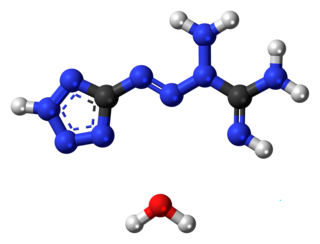Related Research Articles

An explosive is a reactive substance that contains a great amount of potential energy that can produce an explosion if released suddenly, usually accompanied by the production of light, heat, sound, and pressure. An explosive charge is a measured quantity of explosive material, which may either be composed solely of one ingredient or be a mixture containing at least two substances.

Trinitrotoluene, more commonly known as TNT, more specifically 2,4,6-trinitrotoluene, and by its preferred IUPAC name 2-methyl-1,3,5-trinitrobenzene, is a chemical compound with the formula C6H2(NO2)3CH3. TNT is occasionally used as a reagent in chemical synthesis, but it is best known as an explosive material with convenient handling properties. The explosive yield of TNT is considered to be the standard comparative convention of bombs and asteroid impacts. In chemistry, TNT is used to generate charge transfer salts.

A calorimeter is an object used for calorimetry, or the process of measuring the heat of chemical reactions or physical changes as well as heat capacity. Differential scanning calorimeters, isothermal micro calorimeters, titration calorimeters and accelerated rate calorimeters are among the most common types. A simple calorimeter just consists of a thermometer attached to a metal container full of water suspended above a combustion chamber. It is one of the measurement devices used in the study of thermodynamics, chemistry, and biochemistry.

HMX, also called octogen, is a powerful and relatively insensitive nitroamine high explosive, chemically related to RDX. The compound's name is the subject of much speculation, having been variously listed as High Melting Explosive, High-velocity Military Explosive, or High-Molecular-weight RDX.
An explosive booster is a sensitive explosive charge that acts as a bridge between a conventional detonator and a low-sensitivity explosive such as TNT. By itself, the initiating detonator would not deliver sufficient energy to set off the low-sensitivity charge. However, it detonates the primary charge, which then delivers an explosive shockwave that is sufficient to detonate the secondary, main, high-energy charge.
Figure of Insensitivity is an inverse scale of measure of the impact sensitivity of an explosive substance. In this particular context the term 'Insensitivity' refers to the likelihood of initiation/detonation by impact, friction, electrostatic discharge, application of flame, etc. It is a quantitative measure of the level of stimulus required to cause explosive decomposition.

Flash powder is a pyrotechnic composition, a mixture of oxidizer and metallic fuel, which burns quickly (deflagrates) and produces a loud noise regardless of confinement. It is widely used in theatrical pyrotechnics and fireworks and was once used for flashes in photography.
The safety testing of explosives involves the determination of various properties of the different energetic materials that are used in commercial, mining, and military applications. It is highly desirable to measure the conditions under which explosives can be set off for several reasons, including: safety in handling, safety in storage, and safety in use.

FOX-7 or 1,1-diamino-2,2-dinitroethylene(DADNE) is an insensitive high explosive compound. It was first synthesized in 1998 by the Swedish National Defence Research Institute (FOS). The name FOX-7 is derived from the acronym of the Swedish Defence Research Agency (FOI), with the I replaced by an X to indicate an explosive, as in RDX and HMX.

Hexamethylene triperoxide diamine (HMTD) is a high explosive organic compound. HMTD is an organic peroxide, a heterocyclic compound with a cage-like structure. It is a primary explosive. It has been considered as an initiating explosive for blasting caps in the early part of 20th century, mostly because of its high initiating power and its inexpensive production. As such, it was quickly taken up as a primary explosive in mining applications. However, it has since been superseded by more (chemically) stable compounds such as dextrinated lead azide and DDNP. HMTD is widely used in amateur-made blasting caps.

Diazodinitrophenol (DDNP) was the first diazo compound produced; it was subsequently used to make dyes and explosives. It forms yellow crystals in pure form; however, the color of impure forms may vary from dark yellow to green to dark brown. It is soluble in acetic acid, acetone, concentrated hydrochloric acid, most non-polar solvents and is slightly soluble in water.

Hexanitrohexaazaisowurtzitane, also called HNIW and CL-20, is a polycyclic nitroamine explosive with the formula C6H6N12O12. In the 1980s, CL-20 was developed by the China Lake facility, primarily to be used in propellants. It has a better oxidizer-to-fuel ratio than conventional HMX or RDX. It releases 20% more energy than traditional HMX-based propellants, and is widely superior to conventional high-energy propellants and explosives.
Polyvinyl nitrate (abbreviated: PVN) is a high-energy polymer with the idealized formula of [CH2CH(ONO2)]. Polyvinyl nitrate is a long carbon chain (polymer) with nitrate groups bonded randomly along the chain. PVN is a white, fibrous solid, and is soluble in polar organic solvents such as acetone. PVN can be prepared by nitrating polyvinyl alcohol with an excess of nitric acid. Because PVN is also a nitrate ester such as nitroglycerin (a common explosive), it exhibits energetic properties and is commonly used in explosives and propellants.

Erythritol tetranitrate (ETN) is an explosive compound chemically similar to PETN, though it is thought to be slightly more sensitive to friction and impact.

Tetrazene is an explosive material used for sensitization of priming compositions. It is a derivative of the compound with the IUPAC name tetrazene.

Nickel hydrazine nitrate (NHN), (chemical formula: [Ni(N2H4)3](NO3)2 is an energetic material having explosive properties in between that of primary explosive and a secondary explosive. It is a salt of a coordination compound of nickel with a reaction equation of 3N2H4·H2O + Ni(NO3)2 →〔Ni(N2H4)3〕(NO3)2 + 3H2O

1-Diazidocarbamoyl-5-azidotetrazole, often jokingly referred to as azidoazide azide, is a heterocyclic inorganic compound with the formula C2N14. It is a highly reactive and extremely sensitive explosive.
References
- ↑ NAVSEA OP 5, Volume 1. U.S. Navy.
- ↑ Muravyev, Nikita V.; Meerov, Dmitry B.; Monogarov, Konstantin A.; Melnikov, Igor N.; Kosareva, Ekaterina K.; Fershtat, Leonid L.; Sheremetev, Aleksei B.; Dalinger, Igor L.; Fomenkov, Igor V.; Pivkina, Alla N. (October 2021). "Sensitivity of energetic materials: Evidence of thermodynamic factor on a large array of CHNOFCl compounds". Chemical Engineering Journal. 421: 129804. doi:10.1016/j.cej.2021.129804.
- ↑ Klapötke, Thomas M. (2012). Chemistry of high-energy materials (Second ed.). Berlin/Boston. ISBN 978-3-11-027359-5. OCLC 796384242.
{{cite book}}: CS1 maint: location missing publisher (link) - ↑ Muravyev, Nikita V.; Meerov, Dmitry B.; Monogarov, Konstantin A.; Melnikov, Igor N.; Kosareva, Ekaterina K.; Fershtat, Leonid L.; Sheremetev, Aleksei B.; Dalinger, Igor L.; Fomenkov, Igor V.; Pivkina, Alla N. (October 2021). "Sensitivity of energetic materials: Evidence of thermodynamic factor on a large array of CHNOFCl compounds". Chemical Engineering Journal. 421: 129804. doi:10.1016/j.cej.2021.129804.